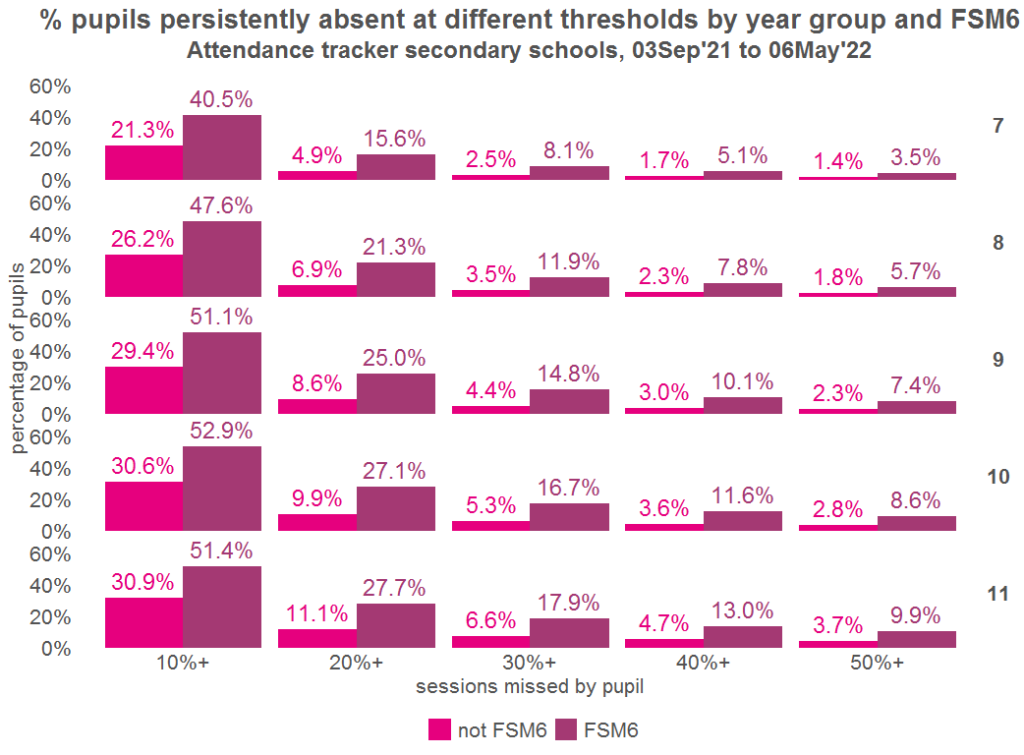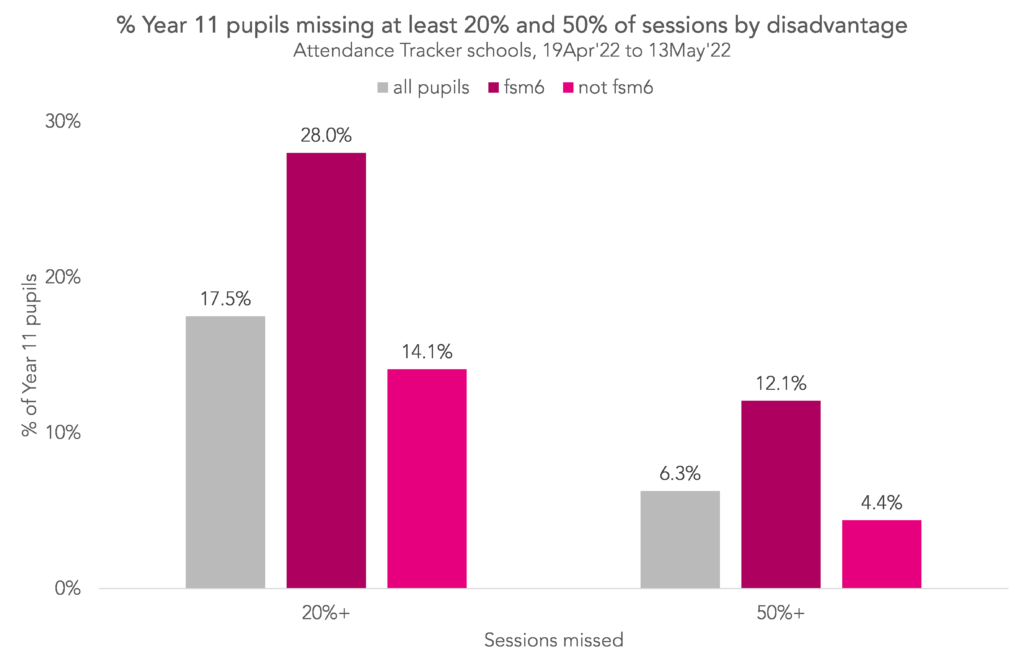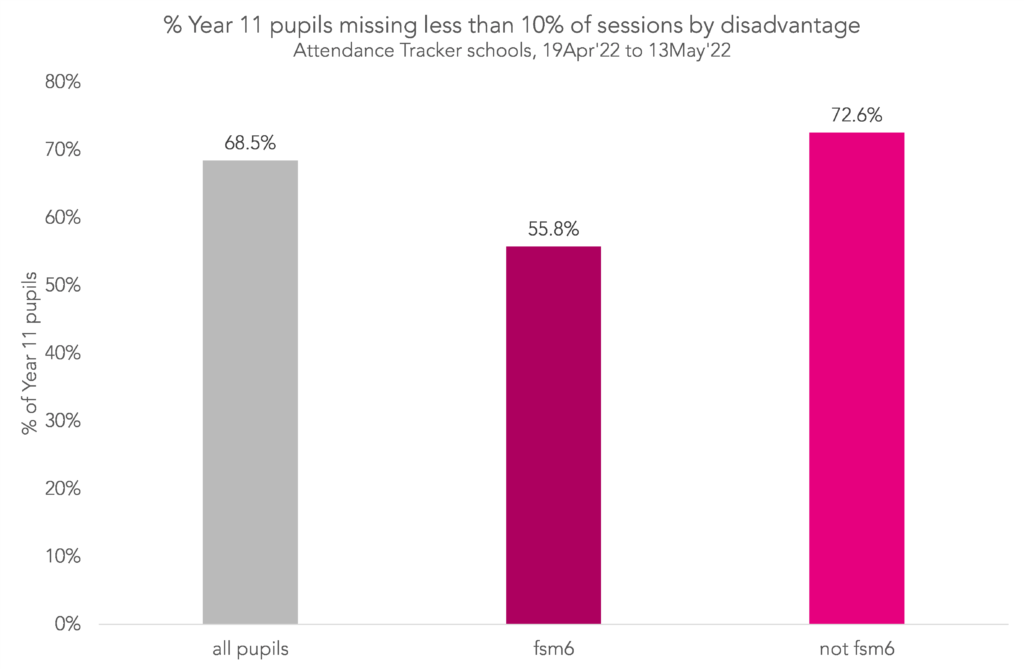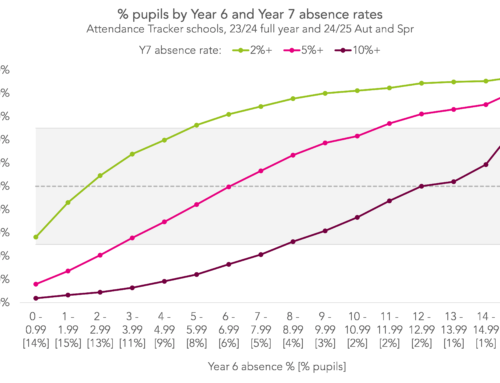Aspire Attendance Tracker
Schools can track, analyse and compare their attendance data against 1,000s of other FFT schools using Aspire Attendance Tracker.
Log in to Aspire to access Attendance Tracker – log in here.
Not an FFT Aspire user? Learn more here.
This week marks the start of the first external GCSE exam period since 2019.
Using data from around 2,600 secondary schools subscribed to Attendance Tracker, we’re going to look at Year 11 absence, with a particular focus on the period between Easter and the start of exams – crucial preparation time for so many pupils.
How much school have Year 11 missed this year?
Let’s start by looking at the year as a whole – from the start of September to the end of Spring Term.

Year 11 pupils missed an average of 11.1% of morning and afternoon registration sessions due to absence[1] during this period. This is the highest absence rate of any year group, and just under double the rate recorded by Year 11 pupils, pre-pandemic.
It is an improvement compared with last year’s Year 11s though. We reckoned they missed 15% of sessions in the same time period excluding the national lockdown which lasted most of Spring Term.
To add more detail to the picture, let’s look at the distribution of pupils by their absence rates over the same period. To do this, I calculate the percentage of students missing at least 10%, 20%, 30%, 40% and 50% of sessions.

We see that Year 11 tended to have the highest proportion of pupils in each of the absence groupings. And, as was the case for overall absence, the proportion of pupils missing lots of school is much higher than pre-pandemic, when around 15% of Year 11s had absence rates of at least 10%.
Pupils with very high absence rates have an outsized contribution to overall absence. The 15.1% of Year 11 pupils who missed at least 20% of sessions contributed around half of the overall absence marks in Year 11.
To finish off this section, let’s look at the same chart split by pupil disadvantage.

Perhaps unsurprisingly given our previous coverage of the topic, there are huge disparities across the board. In Year 11, 27.7% of disadvantaged pupils missed at least 20% of sessions, the equivalent of at least a day a week, compared with 11.1% of their peers. And 9.9% of disadvantaged pupils missed more school than they attended, compared with 3.7% of their peers.
How disrupted have the last few weeks been?
Let’s focus now on the last few weeks – the period between the end of the Easter holidays and the start of exams.
At 11.0%, the percentage of sessions missed by Year 11s since Easter is very similar to the 11.1% of sessions missed between September and Easter. So, on the face of it, it doesn’t look like there’s been a drastic improvement.
To dig down further, I’ll again look at the distribution of pupils by absence rates. However, because we’re talking about a relatively small number of possible days for Year 11 to have attended, I’ll just use the 20%+ and 50%+ groups.

Again, we see that a much bigger proportion of disadvantaged pupils have missed a lot of school over the past few weeks. Around one in eight disadvantaged pupils have missed more school than they’ve attended compared with around 1 in 20 of their peers.
To compound this, the majority of pupils who’ve missed large amounts of school during this exam build-up period also missed lots of school throughout the rest of the year. Of those who missed more school than they attended over the last couple of weeks:
- 5% of them had missed at least 20% of sessions before Easter
- 7% of them had missed at least 50% of sessions.
To finish, let’s look at the other side of the coin: pupils who have missed little school since Easter. I’ll quantify that as less than 10% of sessions missed[2].

Overall, 68.5% of pupils have been mostly present – 55.8% of disadvantaged pupils and 72.6% of their peers.
The majority of these pupils hadn’t missed much school during the rest of the year either: 42% of them missed less than 5% of sessions and 75% missed less than 10%.
A small proportion of them had missed a lot of school, though: 4% missed more than 20% of sessions throughout the rest of the year. Scaled up to the full national population of Year 11s, this is around 8,500 pupils. Many of them will have overcome huge obstacles to achieve this.
Summing up
Absence has been high for Year 11s all year, and not much has changed in the past few weeks. Those who missed lots of the exam build-up period tended to have also missed lots of school before Easter, and those who were mostly present tended to have been mostly present before Easter too.
For most pupils taking part in this year’s GCSEs, the last “normal” year they experienced was Year 8. Of course, we’re all anxiously waiting to see the impact of disruption on grades. But, for many pupils, completing a set of GCSE exams against such an extraordinary backdrop is as a success in and of itself.
[1] Here, as always in our posts, we count sessions missed due to COVID isolation – “X-coded sessions” – as absences.
[2] This is a deliberately generous definition of “missing little school,” because we’re talking about a three or four week period (depending on where a school’s Easter holiday fell) which included Eid.
Want to stay up-to-date with the latest research from FFT Education Datalab? Sign up to Datalab’s mailing list to get notifications about new blogposts, or to receive the team’s half-termly newsletter.






Without wanting to minimise the problem as “it’s always been like this so there’s nothing to worry about”, it would be interesting to see the chart where persistent absence is split by disadvantage for the same period pre-pandemic, and whether the patterns between different pupil groups have changed in that time. Clearly there is still a lot of work to do to improve pupils’ attendance – and particularly for disadvantaged pupils – but any strategies we use have to be informed by a detailed understanding of what impact the last couple of years have had on different groups of pupils.